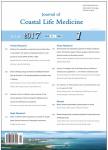Hematological, antioxidant and protective performance of Usnea longissima on chemical induced hepatotoxicity in experimental animals
Hematological, antioxidant and protective performance of Usnea longissima on chemical induced hepatotoxicity in experimental animals作者机构:Pharmacognosy and Ethnopharmacology DivisionCSIR-National Botanical Research InstituteLucknowIndia Amity Institute of PharmacyAmity UniversityLucknowIndia Department of Pharmaceutical SciencesCentral University of RajasthanRajasthanIndia Sherwood College of PharmacyBarabanki-225001India
出 版 物:《Journal of Coastal Life Medicine》 (海岸生命医学杂志(英文版))
年 卷 期:2017年第5卷第5期
页 面:224-232页
基 金:University Grant Commission New Delhi(Grant 201213-RGNF-2012-13-SC-UTT-24384)
主 题:Usnea longissima Carbon tetra chloride (CCl4) Hematological Antioxidant Histopathological
摘 要:Objective: To investigated the hematological, antioxidant and protective performance of Usnea longissima (U. longissima) on CCl4 induced hepatotoxicity in experimental animals. Methods: Hepatotoxicity was induced by CCl4 (1 mL/kg body weigt 1:1 CCl4 i.p.), ethanolic U. longissima extracts at a doses (200 and 400 mg/kg body weigt) were administered to and compared with Silymarin (25 mg/kg body weigt) and hematological, antioxidant and enzymatic, non-enzymatic parameters were assessed through the liver functions test. All the observation was also supplemented with histopathological examination of liver sections. Results: Phytochemical investigation showed that ethanolic extract contains poly phenolic compounds tannins, flavonoids, alkaloids and saponins and acute toxicity study shows that ethanolic extract was safe up to 2000 mg/kg body weight. The toxicant induced a rise in the plasma enzyme levels of ALT, AST, ALP and total bilirubin level. This increased level was significantly decreased by the extract at 400 mg/kg body weight than 200 mg/kg body weight. The animals were prevented (partly or fully) which was showed in the histopathological changes using ethonolic U. longissima extract. Conclusions: The outcome of this study reveals that, there is a powerful antioxidant and hepatoprotective activity of U. longissima. It is believed that the present constituents are responsible for courting the hepatic disease and alternative components have the power to act as free radical scavenging properties.



